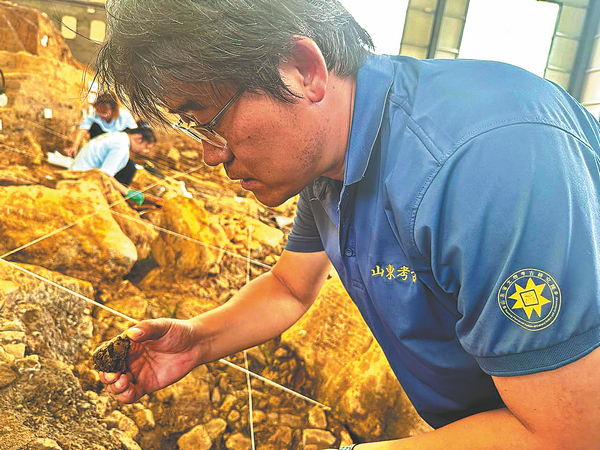

Meaning
Prior to discovering Bashan, archaeologists from the Shandong Institute of Cultural Relics and Archaeology had already discovered a great number of sites from the late Paleolithic and the Paleolithic-to-Neolithic transitional periods in the Yihe River Basin.
"However, the vast majority of stone artifacts were surface finds, posing challenges to dating due to the absence of original strata," Li says. "The discovery of the Bashan site significantly improved the situation."
The excavation of the Bashan site group is focused on multidisciplinary cooperation. The team works on collecting chronological and environmental samples, reinforcing animal bones, conducting indoor CT scanning, and making protection plans for fragile remains. There are also team members analyzing paleogeomorphology (ancient topographic features) and ancient DNA samples. This allows inter-site variability and connections between the Bashan group sites to be discussed based on different kinds of data.
For its key academic value and cultural significance, the Bashan site group was listed as one of China's top 10 new archaeological discoveries last year, and its discovery marked a turning point in improving Paleolithic archaeology in Shandong.
Exploration of the province's Paleolithic sites began in 1965 when animal fossils were unearthed at the Qianrendong cave in Yiyuan county, Zibo city. A joint effort between the Shandong Provincial Museum and the Institute of Vertebrate Paleontology and Paleoanthropology at the Chinese Academy of Sciences then discovered stone artifacts made of vein quartz.
The following year, a fossilized human tooth was found in Xintai city. This discovery marked the beginning of a series of findings on the Jiaodong Peninsula in eastern Shandong, where stone tools and vertebrate fossils were found.
Throughout the 1980s, a nationwide survey of artifacts propelled archaeological work in southern Shandong and on the eastern coast of the province. Notable discoveries during this period included the unearthing of the Yiyuan Man skull and seven teeth in 1981, which demonstrated traits akin to Peking Man and Anhui province's Yuanmou Man, a stage in the development of Homo erectus.
In 1982, 700-odd pieces of microlith (small fragments of stone, often flints) were discovered at the Fenghuangling site in Linyi, the first find of microlithic remains discovered in Shandong.
Entering the new millennium, efforts in Shandong have focused on three river basins where over 50 Paleolithic sites have been discovered.
Compared to other provinces in northern China, Shandong boasts a significant number of late Paleolithic sites.
"Despite the numerous discoveries of Paleolithic sites, the lack of primary strata has hindered comprehensive research in Shandong," Li says. "The Bashan site group discovery has filled in critical gaps in Paleolithic archaeology in the province, paving the way for continued in-depth Paleolithic archaeological work in the region."
Contact the writer at zhaoruixue@chinadaily.com.cn